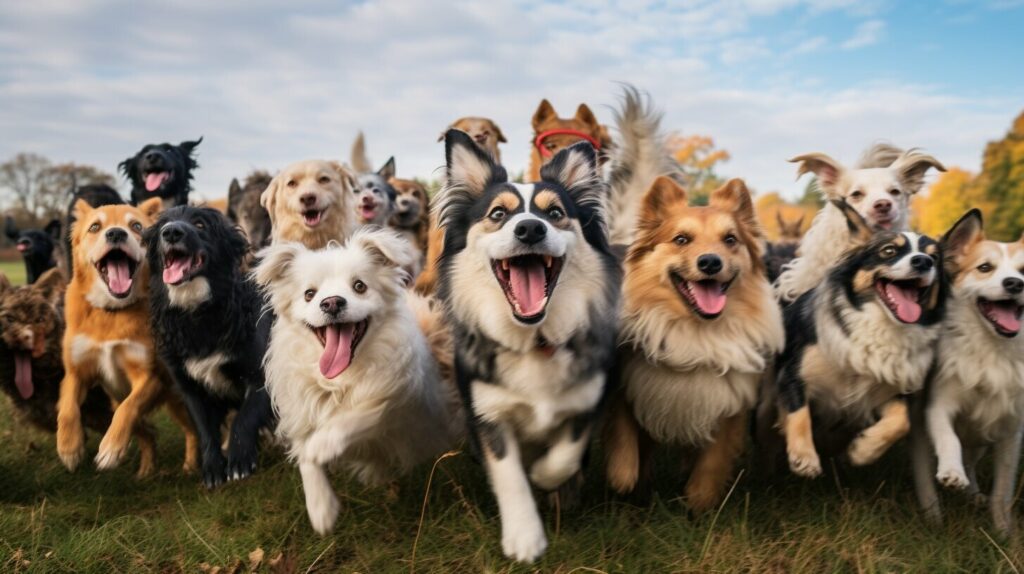As a dog owner, you may have experienced your furry friend’s howling behavior at some point. Many people assume that dogs only howl when they are sad or lonely, but this is not always the case. Howling is a natural behavior for dogs, and it can signify a range of emotions and needs.
In this comprehensive guide, we will explore the reasons behind why dogs howl, the triggers that can cause howling behavior, and effective strategies for managing and controlling howling. Understanding your dog’s howling behavior is crucial in building a strong bond and creating a happy home environment for both you and your furry friend.
Key Takeaways:
- Howling is a natural behavior for dogs that can signify a range of emotions and needs.
- There are many triggers that can cause howling behavior, including separation anxiety, sirens, and other dogs howling.
- Effective strategies for managing and controlling howling include training, providing alternative outlets for the howling instinct, and seeking professional help when necessary.
The Nature of Howling in Dogs
Howling is a natural behavior in dogs, and some breeds are particularly known for their howling tendencies. Understanding why dogs howl can help you decipher what your pet is trying to tell you, and may help you manage excessive howling.
Howling is an evolutionary behavior that has been passed down through generations of wild canids. Howling allows dogs to communicate with other pack members over long distances. In domesticated dogs, howling can be a way to communicate with their owners or other dogs in their household.
Some dog breeds are predisposed to howling, including Siberian Huskies, Alaskan Malamutes, and Beagles. These breeds were traditionally used for hunting or sledding, and their howling behavior was useful in communicating with their human handlers and other dogs in their pack.
The Howling Behavior of Different Breeds
Each breed has unique characteristics that contribute to their howling behavior. Siberian Huskies and Alaskan Malamutes, for example, are often prone to howling when left alone for extended periods of time, which is a behavior that reflects their pack mentality and their desire to communicate with others.
Beagles are another breed that is known for their howling, which can be quite loud and intense. Beagles were bred to hunt in packs, and their howling is a way to communicate with the other dogs in their pack while out on the hunt.
Other breeds that are known for their howling include Bloodhounds, Basset Hounds, and Coonhounds. These breeds were traditionally used for hunting, and their howling was useful in locating prey or communicating with their human handlers.
Overall, howling is a normal behavior in dogs, and it’s important for pet owners to not only recognize it, but to understand why their pets may be howling. Knowing the breed-specific tendencies towards howling can help owners manage this behavior and create a more harmonious living environment.
Triggers for Howling in Dogs
Dogs howl as a form of communication, indicating their emotional state or physical needs. Understanding the triggers that cause dogs to howl is an essential aspect of managing and controlling howling behavior in dogs.
Separation Anxiety
Separation anxiety is a common trigger for howling in dogs. When dogs become overly attached to their owners, they may become anxious when left alone, resulting in howling and other destructive behaviors. To prevent separation anxiety, it is crucial to train your dog to be comfortable with being alone gradually. Techniques such as crate training, providing interactive toys, and leaving the radio or television on while away can help ease anxiety.
Sirens
Sirens from emergency vehicles or other loud noises such as fireworks or thunderstorms can trigger howling in dogs. Dogs have sensitive hearing, and sudden loud noises can be overwhelming, causing them to howl. To manage this behavior, it is essential to establish a safe, quiet space for your dog during times of increased noise. Providing mental stimulation or using calming aids such as pheromone diffusers can also help reduce anxiety around loud noises.
Other Dogs Howling
Dogs are highly social animals and communicate with one another through vocalizations such as barks and howls. When a dog hears another dog howling, they may respond with their howl, creating a howling chain reaction. To prevent this behavior, it is crucial to socialize your dog early on and work on obedience training that emphasizes non-vocal commands.
Territorial Instincts
Dogs may howl to mark their territory or warn off perceived intruders, such as other dogs or strangers. This behavior is more common in certain breeds or dogs that have not been adequately socialized. To prevent territorial howling, it is essential to establish clear boundaries and rules with your dog. Consistent training and positive reinforcement can help reinforce these boundaries and reduce territorial behavior.
Understanding the triggers that cause howling in dogs is an essential aspect of managing this behavior. By managing anxiety, reducing noise, socializing dogs, and establishing clear boundaries, dog owners can train their dogs to exhibit calm behavior and minimize excessive howling.
Breed-Specific Howling Behavior
Different dog breeds have varying tendencies toward howling. While some breeds are known for their frequent and loud howling, others rarely howl at all. Understanding these breed-specific behaviors can help you better manage your dog’s howling habit.
Beagle
Beagles are known for their love of the hunt and their tendency to howl when on the scent of prey. This breed is highly vocal and may howl simply out of boredom or to get attention. To help control your beagle’s howling, provide plenty of exercise and mental stimulation.
Husky
Huskies are a breed known for their distinctive howling, which they use to communicate with their pack. These dogs are highly social and thrive in an active household. If you’re considering a husky, be prepared for their vocal tendencies and provide plenty of opportunities for exercise and play.
Basset Hound
Basset Hounds have a deep, mournful howl that they use to communicate with their owners and their pack. This breed is known for being stubborn and independent, so training and consistency are key to managing their howling behavior.
Bearded Collie
Bearded Collies are a breed known for their herding instincts, which can lead to howling behavior when they feel they need to protect their flock. This breed is highly intelligent and responds well to training, so consistency and positive reinforcement can help control their howling.
Dachshund
Dachshunds are a small breed with a big voice. They are known for their high-pitched barks and occasional howling. This breed is affectionate and loyal, but can be prone to separation anxiety, which may contribute to excessive howling. Providing mental stimulation and comfort can help reduce their howling behavior.
Conclusion
Understanding your dog’s breed-specific howling tendencies can help you better manage their behavior and control excessive howling. Providing plenty of exercise, mental stimulation, and consistent training can all help reduce howling behavior in your furry friend.
Managing Howling Behavior
If you’re dealing with a howling dog, there are practical steps you can take to manage the behavior. By understanding the triggers behind the howling, you can help your dog feel more secure and ultimately reduce their need to howl excessively.
Here are some tips to help you control and prevent dog howling:
- Train your dog: Providing basic training and consistency can go a long way in managing howling behavior. Teach your dog basic commands such as “quiet” and “stay” so you can redirect their attention when howling becomes excessive.
- Redirect the behavior: Give your dog an alternative outlet for their howling instincts. Provide them with interactive toys or games that require mental stimulation and physical activity.
- Desensitize your dog: Introduce your dog to the triggers that cause them to howl in a controlled environment, gradually increasing the level of exposure over time. This can help reduce their sensitivity to certain stimuli.
- Use positive reinforcement: Reward your dog for good behavior with treats and praise. Positive reinforcement has been shown to be effective in modifying dog behavior.
- Look for underlying issues: Sometimes howling behavior can be a symptom of an underlying issue, such as separation anxiety or boredom. Addressing these issues can help minimize howling.
Remember, managing howling behavior requires patience and consistency. It may take some time and effort to see results, but with the right approach, you can help your dog feel more secure and reduce their need to howl excessively.
Training Dogs to Not Howl
If your dog’s howling behavior is becoming excessive, it’s essential to address it as soon as possible. Fortunately, training your dog to not howl is possible with consistence and the right techniques.
Positive reinforcement: One of the most effective training methods is positive reinforcement. Rewarding your dog when they remain quiet is a simple yet effective way to discourage howling behavior. Start by giving treats when they stay quiet for a few seconds, gradually increasing the duration until they learn to stay quiet for extended periods.
Desensitization: Desensitization involves gradually exposing your dog to stimuli that trigger their howling behavior. Start by playing a recording of a sound that triggers howling, such as sirens, at a low volume. Reward your dog when they remain calm and gradually increase the volume over time.
Counter-conditioning: Counter-conditioning involves replacing the negative association your dog has with a stimulus with a positive one. For example, if your dog howls when you leave the house, you can try leaving them with a toy or puzzle that they enjoy to distract them from your departure.
It’s essential to remember that training takes time and patience. Consistency is key, and you need to reinforce good behavior continually. Never punish your dog for howling, as this can increase their anxiety and worsen the behavior. Instead, try redirection techniques to provide alternative outlets for their howling instincts.
Seeking Professional Help
If your efforts to manage your dog’s howling behavior have been unsuccessful, seeking professional help is a viable option. Consulting with a veterinarian or professional dog trainer can help address any underlying issues and provide specific strategies for your dog’s unique needs. In some cases, medication may be recommended to help manage excessive howling.
When choosing a professional, look for someone with experience working with howling dogs. Ask for references and check reviews online to ensure that they have a good reputation. Be prepared to share detailed information about your dog’s behavior, including when and where they howl, as well as any triggers that seem to cause the behavior.
Remember, there is no shame in seeking help. Professional guidance can be the key to successfully managing your dog’s howling behavior and creating a peaceful and harmonious home environment.
Addressing Underlying Issues
If your dog is excessively howling, there may be underlying issues contributing to this behavior. Identifying and addressing these issues can help reduce or eliminate the howling altogether.
Separation Anxiety
Separation anxiety is a common cause of excessive howling in dogs. If your dog becomes overly anxious or distressed when left alone, they may start howling to show their distress. To address this issue, you can try gradually desensitizing your dog to your comings and goings. Start by leaving for short periods and gradually increasing the time you are away. Providing your pup with comfortable bedding, toys, and a special treat can also help alleviate anxiety.
Boredom
Dogs that are bored or lack mental and physical stimulation may also start howling. Providing your dog with plenty of exercise, playtime, and interactive toys can help alleviate boredom. Consider taking your dog for regular walks, enrolling them in obedience or agility classes, or engaging them in interactive games.
Medical Issues
In some cases, medical issues can contribute to excessive howling in dogs. Pain, hearing loss, and age-related cognitive decline can all trigger howling behavior. If you suspect that your dog’s howling may be due to a medical issue, consult with a veterinarian to rule out any underlying health problems.
Creating a Howl-Free Environment
If you’re dealing with a howling dog, creating a howl-free environment can make a big difference. Here are some practical tips to help you prevent dog howling:
- Provide mental and physical stimulation: Boredom can cause excessive howling, so make sure to keep your dog entertained with toys, games, and daily exercise.
- Soundproof your home: If your dog is triggered by outside noises, a soundproofing solution could make a big difference in reducing howling behavior. Consider installing soundproof curtains or using white noise machines to create a more peaceful environment.
- Use calming aids: Products such as pheromone diffusers, calming supplements, and anxiety vests can help soothe your dog and reduce howling.
- Establish a calming routine: Create a consistent daily routine that includes plenty of rest, exercise, and relaxing activities. This can help your dog feel more secure and reduce anxiety-related howling.
- Consistency: Finally, make sure to be consistent with your training and management strategies. Dogs thrive on routine and predictability, so make sure to establish a clear and consistent plan for managing howling behavior.
Section 10: Conclusion
Congratulations! You have now gained a comprehensive understanding of dogs that howl. By reading this article, you have learned about the evolutionary reasons behind howling behavior and the triggers that can cause your dog to howl. You are also now aware of the specific breeds known for their howling tendencies and the methods to manage and control howling behavior.
Remember, training and consistency are key when it comes to managing howling behavior in your dog. Positive reinforcement, desensitization, and counter-conditioning techniques are effective methods for training your dog to not howl excessively.
If you’re dealing with more severe cases of howling, seeking professional help from a veterinarian or a professional dog trainer may be necessary. And if there are underlying issues contributing to howling behavior, such as separation anxiety or boredom, addressing these issues can help reduce or eliminate howling.
Creating a howl-free environment is also possible by soundproofing your home, providing mental and physical stimulation, and using calming aids. Creating a calming routine and consistent structure can also help minimize howling.
Thank you for taking the time to read this guide on dogs that howl. By implementing the techniques and strategies discussed, you can help manage and control your dog’s howling behavior and strengthen your bond with your furry friend.
FAQ
Q: What causes dogs to howl?
A: There are various triggers that can cause dogs to howl. Common causes include separation anxiety, sirens, other dogs howling, and territorial instincts.
Q: Are certain dog breeds more prone to howling?
A: Yes, certain dog breeds are known for their howling tendencies. Breeds such as Huskies, Beagles, and Alaskan Malamutes are more likely to howl.
Q: Can excessive howling be trained out of a dog?
A: Yes, with proper training and consistency, excessive howling can be managed. Techniques such as positive reinforcement, desensitization, and counter-conditioning can help train a dog to not howl excessively.
Q: When should I seek professional help for my howling dog?
A: If your dog’s howling is causing significant disruption or distress, it may be necessary to consult with a veterinarian or professional dog trainer. They can provide guidance and recommend appropriate solutions.
Q: What underlying issues should I consider when addressing howling behavior?
A: Excessive howling can be a symptom of underlying issues such as separation anxiety, boredom, or health conditions. It is important to address these issues in order to reduce or eliminate howling behavior.
Q: How can I create a howl-free environment for my dog?
A: Creating a howl-free environment involves soundproofing options, providing mental and physical stimulation, and using calming aids. Establishing a calming routine and maintaining a consistent structure can also help minimize howling.



